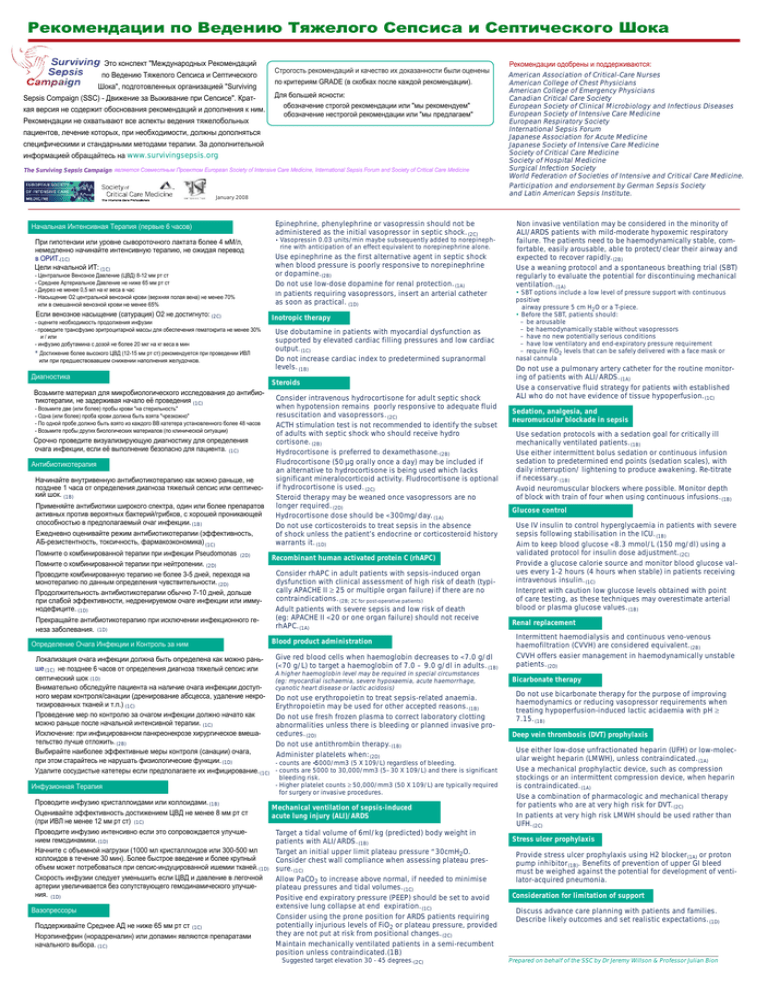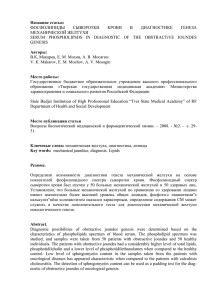фрагмент перевода - Клинические рекомендации
advertisement

Рекомендации по Ведению Тяжелого Сепсиса и Септического Шока Это конспект "Международных Рекомендаций Строгость рекомендаций и качество их доказанности были оценены по Ведению Тяжелого Сепсиса и Септического по критериям GRADE (в скобках после каждой рекомендации). Шока", подготовленных организацией "Surviving Для большей ясности: ◆ обозначение строгой рекомендации или "мы рекомендуем" ◆ обозначение нестрогой рекомендации или "мы предлагаем" Sepsis Compaign (SSC) - Движение за Выживание при Сепсисе". Краткая версия не содержит обоснования рекомендаций и дополнения к ним. Рекомендации не охватывают все аспекты ведения тяжелобольных пациентов, лечение которых, при необходимости, должны дополняться специфическими и стандарными методами терапии. За дополнительной информацией обращайтесь на www.survivingsepsis.org The Surviving Sepsis Campaign является Совместным Проектом European Society of Intensive Care Medicine, International Sepsis Forum and Society of Critical Care Medicine January 2008 Начальная Интенсивная Терапия (первые 6 часов) ◆ Epinephrine, phenylephrine or vasopressin should not be administered as the initial vasopressor in septic shock. (2C) ◆ При гипотензии или уровне сывороточного лактата более 4 мМ/л, немедленно начинайте интенсивную терапию, не ожидая перевод в ОРИТ.(1C) ◆ Цели начальной ИТ: (1C) - Центральное Венозное Давление (ЦВД) 8-12 мм рт ст - Среднее Артериальное Давление не ниже 65 мм рт ст - Диурез не менее 0,5 мл на кг веса в час - Насыщение О2 центральной венозной крови (верхняя полая вена) не менее 70% или в смешанной венозной крови не менее 65% ◆ Если венозное насыщение (сатурация) О2 не достигнуто: (2C) - оцените необходимость продолжения инфузии - проведите трансфузию эритроцитарной массы для обеспечения гематокрита не менее 30% и / или - инфузию добутамина с дозой не более 20 мкг на кг веса в мин * Достижение более высокого ЦВД (12-15 мм рт ст) рекомендуется при проведении ИВЛ или при предшествовавшем снижении наполнения желудочков. Диагностика ◆ Возьмите материал для микробиологического исследования до антибио- • Vasopressin 0.03 units/min maybe subsequently added to norepinephrine with anticipation of an effect equivalent to norepinephrine alone. ◆ Use epinephrine as the first alternative agent in septic shock when blood pressure is poorly responsive to norepinephrine or dopamine.(2B) ◆ Do not use low-dose dopamine for renal protection. (1A) ◆ In patients requiring vasopressors, insert an arterial catheter as soon as practical. (1D) dobutamine in patients with myocardial dysfunction as supported by elevated cardiac filling pressures and low cardiac output. (1C) ◆ Do not increase cardiac index to predetermined supranormal levels. (1B) Steroids ◆ Blood product administration Локализация очага инфекции должна быть определена как можно рань- ◆ Give red blood cells when haemoglobin decreases to < 7.0 g/dl (< 70 g/L) to target a haemoglobin of 7.0 – 9.0 g/dl in adults. (1B) ше (1C) не позднее 6 часов от определения диагноза тяжелый сепсис или A higher haemoglobin level may be required in special circumstances септический шок (1D) (eg: myocardial ischaemia, severe hypoxaemia, acute haemorrhage, ◆ Внимательно обследуйте пациента на наличие очага инфекции доступcyanotic heart disease or lactic acidosis) ного мерам контроля/санации (дренирование абсцесса, удаление некро- ◆ Do not use erythropoietin to treat sepsis-related anaemia. тизированных тканей и т.п.) (1C) Erythropoietin may be used for other accepted reasons. (1B) ◆ Проведение мер по контролю за очагом инфекции должно начато как ◆ Do not use fresh frozen plasma to correct laboratory clotting можно раньше после начальной интенсивной терапии. (1C) abnormalities unless there is bleeding or planned invasive pro◆ Исключение: при инфицированном панкреонекрозе хирургическое вмешаcedures. (2D) тельство лучше отложить. (2B) ◆ Do not use antithrombin therapy. (1B) ◆ Выбирайте наиболее эффективные меры контроля (санации) очага, ◆ Administer platelets when: (2D) при этом старайтесь не нарушать физиологические функции. (1D) - counts are <5000/mm3 (5 X 109/L) regardless of bleeding. ◆ Удалите сосудистые катетеры если предполагаете их инфицирование. (1C) - counts are 5000 to 30,000/mm3 (5–30 X 109/L) and there is significant ◆ Инфузионная Терапия ◆ Проводите инфузию кристаллоидами или коллоидами. (1B) ◆ Оценивайте эффективность достижением ЦВД не менее 8 мм рт ст Non invasive ventilation may be considered in the minority of ALI/ARDS patients with mild-moderate hypoxemic respiratory failure. The patients need to be haemodynamically stable, comfortable, easily arousable, able to protect/clear their airway and expected to recover rapidly. (2B) ◆ Use a weaning protocol and a spontaneous breathing trial (SBT) regularly to evaluate the potential for discontinuing mechanical ventilation. (1A) ◆ • SBT options include a low level of pressure support with continuous positive airway pressure 5 cm H2O or a T-piece. • Before the SBT, patients should: – be arousable – be haemodynamically stable without vasopressors – have no new potentially serious conditions – have low ventilatory and end-expiratory pressure requirement – require FiO2 levels that can be safely delivered with a face mask or nasal cannula ◆ Use - Возьмите две (или более) пробы крови "на стерильность" - Одна (или более) проба крови должна быть взята "чрезкожно" - По одной пробе должно быть взято из каждого ВВ катетера установленного более 48 часов - Возьмите пробы других биологических материалов (по клинической ситуации) Определение Очага Инфекции и Контроль за ним American Association of Critical-Care Nurses American College of Chest Physicians American College of Emergency Physicians Canadian Critical Care Society European Society of Clinical Microbiology and Infectious Diseases European Society of Intensive Care Medicine European Respiratory Society International Sepsis Forum Japanese Association for Acute Medicine Japanese Society of Intensive Care Medicine Society of Critical Care Medicine Society of Hospital Medicine Surgical Infection Society World Federation of Societies of Intensive and Critical Care Medicine. Participation and endorsement by German Sepsis Society and Latin American Sepsis Institute. Inotropic therapy Consider intravenous hydrocortisone for adult septic shock when hypotension remains poorly responsive to adequate fluid resuscitation and vasopressors. (2C) ◆ ACTH stimulation test is not recommended to identify the subset of adults with septic shock who should receive hydro ◆ Срочно проведите визуализирующую диагностику для определения cortisone. (2B) очага инфекции, если её выполнение безопасно для пациента. (1C) ◆ Hydrocortisone is preferred to dexamethasone.(2B) ◆ Fludrocortisone (50 µg orally once a day) may be included if Антибиотикотерапия an alternative to hydrocortisone is being used which lacks significant mineralocorticoid activity. Fludrocortisone is optional ◆ Начинайте внутривенную антибиотикотерапию как можно раньше, не if hydrocortisone is used. (2C) позднее 1 часа от определения диагноза тяжелый сепсис или септический шок. (1B) ◆ Steroid therapy may be weaned once vasopressors are no longer required. (2D) ◆ Применяйте антибиотики широкого спектра, один или более препаратов активных против вероятных бактерий/грибков, с хорошей проникающей ◆ Hydrocortisone dose should be < 300mg/day. (1A) способностью в предполагаемый очаг инфекции. (1B) ◆ Do not use corticosteroids to treat sepsis in the absence of shock unless the patient’s endocrine or corticosteroid history ◆ Ежедневно оценивайте режим антибиотикотерапии (эффективность, АБ-резистентность, токсичность, фармакоэкономика) (1C) warrants it. (1D) ◆ Помните о комбинированной терапии при инфекции Pseudomonas (2D) Recombinant human activated protein C (rhAPC) ◆ Помните о комбинированной терапии при нейтропении. (2D) ◆ Consider rhAPC in adult patients with sepsis-induced organ ◆ Проводите комбинированную терапию не более 3-5 дней, переходя на dysfunction with clinical assessment of high risk of death (typiмонотерапию по данным определения чувствительности. (2D) cally APACHE II ≥ 25 or multiple organ failure) if there are no ◆ Продолжительность антибиотикотерапии обычно 7-10 дней, дольше contraindications. (2B; 2C for post-operative patients) при слабой эффективности, недренируемом очаге инфекции или иммунодефиците. (1D) ◆ Adult patients with severe sepsis and low risk of death (eg: APACHE II < 20 or one organ failure) should not receive ◆ Прекращайте антибиотикотерапию при исключении инфекционного геrhAPC. (1A) неза заболевания. (1D) тикотерапии, не задерживая начало её проведения (1C) Рекомендации одобрены и поддерживаются: bleeding risk. - Higher platelet counts ≥ 50,000/mm3 (50 X 109/L) are typically required for surgery or invasive procedures. Mechanical ventilation of sepsis-induced acute lung injury (ALI)/ARDS (при ИВЛ не менее 12 мм рт ст) (1C) ◆ Проводите инфузию интенсивно если это сопровождается улучше◆ Target a tidal volume of 6ml/kg (predicted) body weight in нием гемодинамики. (1D) patients with ALI/ARDS. (1B) ◆ Начните с объемной нагрузки (1000 мл кристаллоидов или 300-500 мл ◆ Target an initial upper limit plateau pressure ≤30cmH2O. коллоидов в течение 30 мин). Более быстрое введение и более крупный Consider chest wall compliance when assessing plateau presобъем может потребоваться при сепсис-индуцированной ишемии тканей. (1D) sure. (1C) ◆ Скорость инфузии следует уменьшить если ЦВД и давление в легочной ◆ Allow PaCO to increase above normal, if needed to minimise 2 артерии увеличивается без сопутствующего гемодинамического улучшеplateau pressures and tidal volumes. (1C) ния. (1D) ◆ Positive end expiratory pressure (PEEP) should be set to avoid extensive lung collapse at end expiration. (1C) Вазопрессоры ◆ Consider using the prone position for ARDS patients requiring potentially injurious levels of FiO2 or plateau pressure, provided ◆ Поддерживайте Среднее АД не ниже 65 мм рт ст (1C) they are not put at risk from positional changes. (2C) ◆ Норэпинефрин (норадреналин) или допамин являются препаратами ◆ Maintain mechanically ventilated patients in a semi-recumbent начального выбора. (1C) position unless contraindicated.(1B) ◆ Suggested target elevation 30 - 45 degrees.(2C) Do not use a pulmonary artery catheter for the routine monitoring of patients with ALI/ARDS. (1A) ◆ Use a conservative fluid strategy for patients with established ALI who do not have evidence of tissue hypoperfusion. (1C) ◆ Sedation, analgesia, and neuromuscular blockade in sepsis Use sedation protocols with a sedation goal for critically ill mechanically ventilated patients. (1B) ◆ Use either intermittent bolus sedation or continuous infusion sedation to predetermined end points (sedation scales), with daily interruption/ lightening to produce awakening. Re-titrate if necessary. (1B) ◆ Avoid neuromuscular blockers where possible. Monitor depth of block with train of four when using continuous infusions. (1B) ◆ Glucose control Use IV insulin to control hyperglycaemia in patients with severe sepsis following stabilisation in the ICU. (1B) ◆ Aim to keep blood glucose < 8.3 mmol/L (150 mg/dl) using a validated protocol for insulin dose adjustment. (2C) ◆ Provide a glucose calorie source and monitor blood glucose values every 1-2 hours (4 hours when stable) in patients receiving intravenous insulin. (1C) ◆ Interpret with caution low glucose levels obtained with point of care testing, as these techniques may overestimate arterial blood or plasma glucose values. (1B) ◆ Renal replacement ◆ Intermittent haemodialysis and continuous veno-venous haemofiltration (CVVH) are considered equivalent. (2B) ◆ CVVH offers easier management in haemodynamically unstable patients. (2D) Bicarbonate therapy ◆ Do not use bicarbonate therapy for the purpose of improving haemodynamics or reducing vasopressor requirements when treating hypoperfusion-induced lactic acidaemia with pH ≥ 7.15. (1B) Deep vein thrombosis (DVT) prophylaxis Use either low-dose unfractionated heparin (UFH) or low-molecular weight heparin (LMWH), unless contraindicated. (1A) ◆ Use a mechanical prophylactic device, such as compression stockings or an intermittent compression device, when heparin is contraindicated. (1A) ◆ Use a combination of pharmacologic and mechanical therapy for patients who are at very high risk for DVT. (2C) ◆ In patients at very high risk LMWH should be used rather than UFH. (2C) ◆ Stress ulcer prophylaxis ◆ Provide stress ulcer prophylaxis using H2 blocker (1A) or proton pump inhibitor (1B). Benefits of prevention of upper GI bleed must be weighed against the potential for development of ventilator-acquired pneumonia. Consideration for limitation of support ◆ Discuss advance care planning with patients and families. Describe likely outcomes and set realistic expectations. (1D) Prepared on behalf of the SSC by Dr Jeremy Willson & Professor Julian Bion
